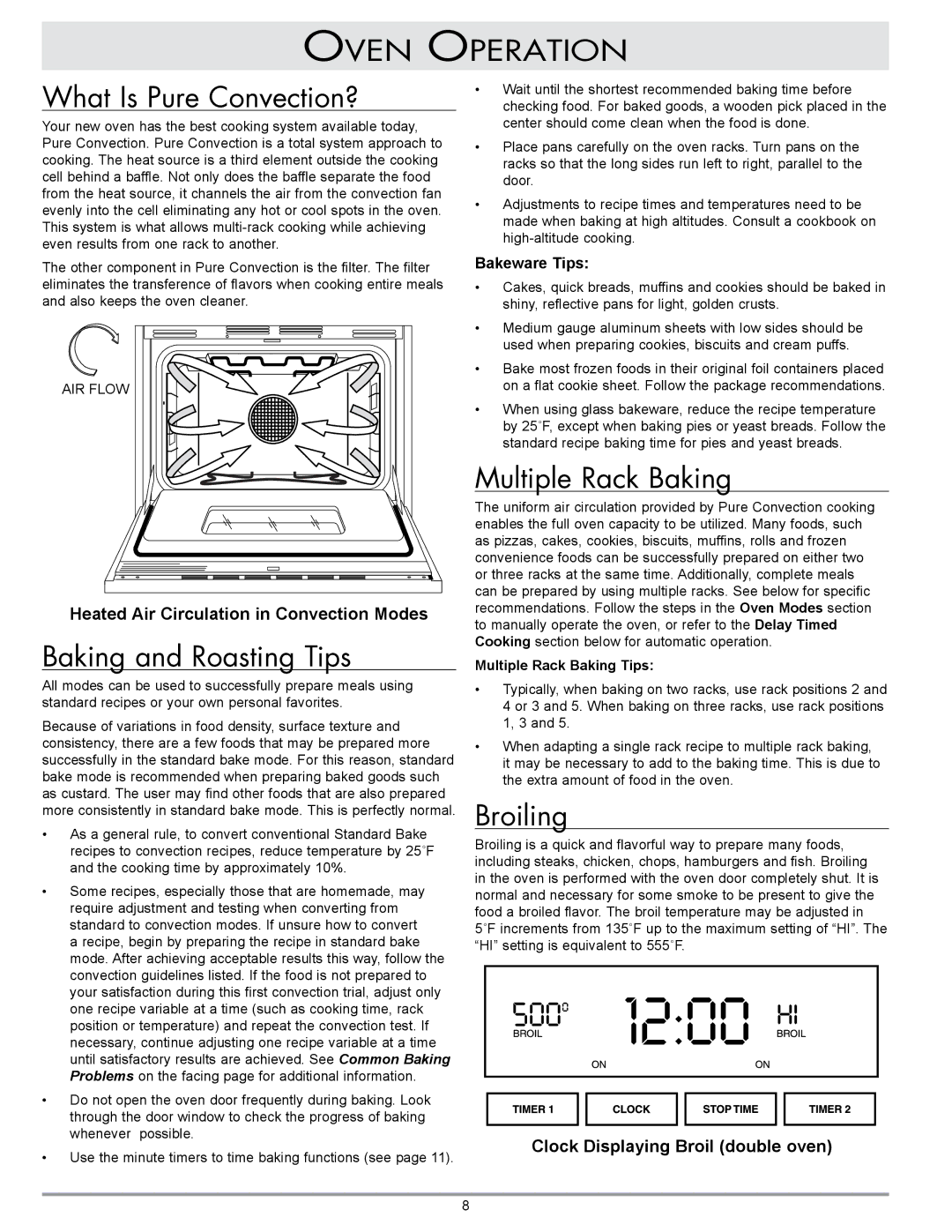
Oven Operation
What Is Pure Convection?
Your new oven has the best cooking system available today, Pure Convection. Pure Convection is a total system approach to cooking. The heat source is a third element outside the cooking cell behind a baffle. Not only does the baffle separate the food from the heat source, it channels the air from the convection fan evenly into the cell eliminating any hot or cool spots in the oven. This system is what allows
•Wait until the shortest recommended baking time before checking food. For baked goods, a wooden pick placed in the center should come clean when the food is done.
•Place pans carefully on the oven racks. Turn pans on the racks so that the long sides run left to right, parallel to the door.
•Adjustments to recipe times and temperatures need to be made when baking at high altitudes. Consult a cookbook on
The other component in Pure Convection is the filter. The filter eliminates the transference of flavors when cooking entire meals and also keeps the oven cleaner.
AIR FLOW
Heated Air Circulation in Convection Modes
Baking and Roasting Tips
All modes can be used to successfully prepare meals using standard recipes or your own personal favorites.
Because of variations in food density, surface texture and consistency, there are a few foods that may be prepared more successfully in the standard bake mode. For this reason, standard bake mode is recommended when preparing baked goods such as custard. The user may find other foods that are also prepared more consistently in standard bake mode. This is perfectly normal.
•As a general rule, to convert conventional Standard Bake recipes to convection recipes, reduce temperature by 25˚F and the cooking time by approximately 10%.
•Some recipes, especially those that are homemade, may require adjustment and testing when converting from standard to convection modes. If unsure how to convert a recipe, begin by preparing the recipe in standard bake mode. After achieving acceptable results this way, follow the convection guidelines listed. If the food is not prepared to your satisfaction during this first convection trial, adjust only one recipe variable at a time (such as cooking time, rack position or temperature) and repeat the convection test. If necessary, continue adjusting one recipe variable at a time until satisfactory results are achieved. See Common Baking Problems on the facing page for additional information.
•Do not open the oven door frequently during baking. Look through the door window to check the progress of baking whenever possible.
•Use the minute timers to time baking functions (see page 11).
Bakeware Tips:
•Cakes, quick breads, muffins and cookies should be baked in shiny, reflective pans for light, golden crusts.
•Medium gauge aluminum sheets with low sides should be used when preparing cookies, biscuits and cream puffs.
•Bake most frozen foods in their original foil containers placed on a flat cookie sheet. Follow the package recommendations.
•When using glass bakeware, reduce the recipe temperature by 25˚F, except when baking pies or yeast breads. Follow the standard recipe baking time for pies and yeast breads.
Multiple Rack Baking
The uniform air circulation provided by Pure Convection cooking enables the full oven capacity to be utilized. Many foods, such as pizzas, cakes, cookies, biscuits, muffins, rolls and frozen convenience foods can be successfully prepared on either two or three racks at the same time. Additionally, complete meals can be prepared by using multiple racks. See below for specific recommendations. Follow the steps in the Oven Modes section to manually operate the oven, or refer to the Delay Timed Cooking section below for automatic operation.
Multiple Rack Baking Tips:
•Typically, when baking on two racks, use rack positions 2 and 4 or 3 and 5. When baking on three racks, use rack positions 1, 3 and 5.
•When adapting a single rack recipe to multiple rack baking, it may be necessary to add to the baking time. This is due to the extra amount of food in the oven.
Broiling
Broiling is a quick and flavorful way to prepare many foods, including steaks, chicken, chops, hamburgers and fish. Broiling in the oven is performed with the oven door completely shut. It is normal and necessary for some smoke to be present to give the food a broiled flavor. The broil temperature may be adjusted in 5˚F increments from 135˚F up to the maximum setting of “HI”. The “HI” setting is equivalent to 555˚F.
Clock Displaying Broil (double oven)
8
